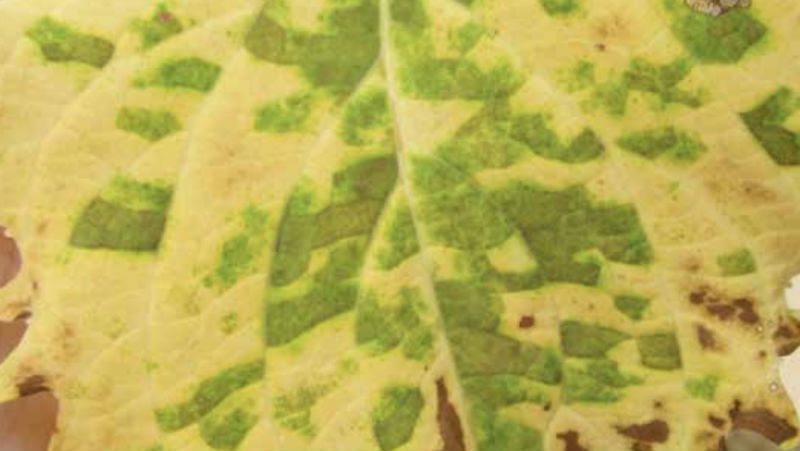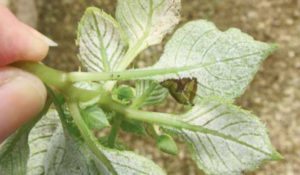
Downy Mildew: Conditions and Controls
1. What environmental conditions favor downy mildew development?
The pathogen is very dependent on environmental conditions for disease development.
Downy mildews require high relative humidity throughout disease development and growth, sporulation and development will cease when conditions become too dry. The high relative humidity commonly found in plant production areas creates a perfect downy mildew environment.
2. Since high relative humidity is essential for downy mildew development, can a grower use environmental conditions and production management to their advantage in the production environment?
Yes. In greenhouse production, downy mildew can be managed to some extent. If susceptible species are being grown, it can be helpful to keep the atmosphere dry. Both humid and moderate temperature growing conditions will favor the pathogens development. In outdoor production areas, however, manipulation of humidity and air temperature is not possible. In many growing areas the time period for downy mildew infections may be short, but can be several times during the year.
Additionally, spores can survive without infecting plant material if unfavorable environmental conditions are present.
3. Are downy mildew spores spread through the air if they are present in the environment?
Yes. Downy mildew can spread rapidly via wind-blown spores. Knowing when the pathogen spores are present is critical to disease management, especially if the crop plants are downy mildew hosts.
Downy mildews primarily infect the above ground plant parts including: leaves, flowers, stems and fruits. Downy mildew can be particularly damaging in ornamentals since it systematically infects the plants. Symptoms like discolored patches on leaf surfaces can appear mosaic-like on the upper leaf surfaces and the spores can appear on the under-side of the leaves
as fuzzy white, downy clusters. Leaf symptoms may appear uncharacteristically not white and fuzzy when you observe downy mildew signs of the fungus on coleus, impatiens and a woody ornamental like viburnum.
These symptoms do not present on all plant species the same way. For example, on certain plant species, like coleus, impatiens or viburnum, the symptoms do not appear white or fuzzy. Although infection does not look the same on all plant species, severe infection can result in complete defoliation and ultimately, plant death.
Despite spread via wind, it is still important to practice plant residue sanitation in production areas. Downy mildew spores can persist on plant residue and dead tissue.
Check with your local land grant university to see if they are involved with spore monitoring. This practice can give growers time to take preventative measures to protect susceptible crops. This is particularly important to track spore counts if ornamental greenhouses are surrounded by large fruit and vegetable production areas. To read more about these monitoring programs, consult universities such as Cornell and Michigan State that have active programs.

4. Control: Where do you begin?
Preventative control is the best strategy. If the greenhouse atmosphere can be manipulated to be less humid, this can help prevent downy mildew. However, if downy mildews are prevalent in your particular geography then prevention may also involve chemical protection.
This brings to mind the second key distinction of downy mildew control versus control of other pathogens that might be encountered in production environments. Downy mildews must be controlled with what are referred to as “specialist” fungicides. Since downy mildews are considered “water molds,” not all fungicides available will provide control. A specialist product that controls downy mildew should be one that reduces and stops sporulation of the pathogen. An anti-sporulant will shut down the epidemic quicker, thus preventing spores from germinating, infecting and reproducing.
Infection may be actively occurring at the time of treatment, so it is important to combine the initial application with a contact fungicide, or “generalist.”
The grower needs to recognize that a product that controls powdery mildews must also list downy mildew, but they are distinctly different fungal species. Examples of downy mildew fungi include: Bremia, Peronospora, Plasmopara, Psuedoperonospora, spp. Remember, if the label does not specifically list downy mildew species, it will not have activity on these fungi.
5. How easy can you identify these “specialist” products?
There are several strong chemistries in the market currently making it easy to implement a good preventative, early curative program for downy mildew control.
BASF offers Stature SC specialist fungicide. Towards the infection period, this fungicide can be combined with a broader spectrum fungicide, like Pageant Intrinsic brand fungicide in bedding plant production or Orkestra Intrinsic brand fungicide in the nursery or longer term crops. These products can also be combined with mancozeb or chlorothalonil if signs of downy mildew infection are present at the time of application.
Other specialist fungicides that can be considered are Adorn or Segovis. These two products are in different mode-of-action groups, and can be used to build an effective fungicide rotation program. Several other broad-spectrum fungicides, including Strike Plus, may be utilized to combine two modes of action — one of which controls downy mildew and the other controls various other species of fungi.
6. What plant species are recognized as susceptible to downy mildew?
In annual plant production, Impatiens walleriana species and coleus have been studied and documented most frequently in recent years. The downy mildew species infecting these plants are different and the environmental conditions for optimal infection differ as well. Other susceptible annuals include pansy and snapdragon. Susceptible perennials include aster, coreopsis, geum, lupine, rudbeckia and veronica. Downy mildew can be a major production disease in woody plant production, particularly in Viburnum spp. Downy mildew is host specific with roses, and occurs from stems to all plant parts. Preventative protection is required.
As winter progresses and temperatures and humidity fluctuate in your operation, be aware that conditions favoring downy mildew can be present.
Always read and follow label directions.
Note: Stature, Pageant and Intrinsic are registered trademarks, and Orkestra is a trademark of BASF Corporation. Adorn is a registered trademark of Valent Corporation. Strike Plus is a registered trademark of OHP. Segovis is a registered trademark of Syngenta Crop Protection.


 Video Library
Video Library 




















